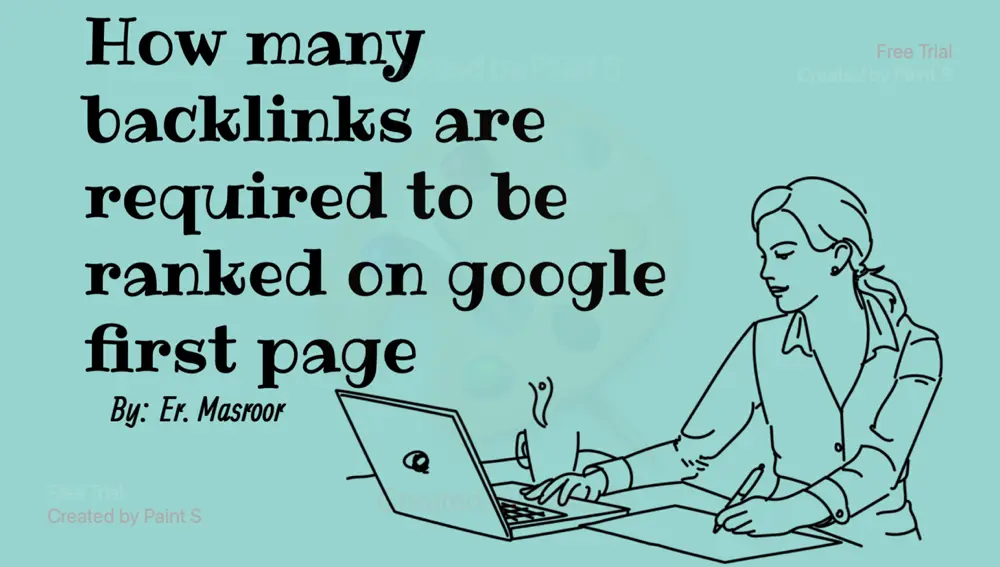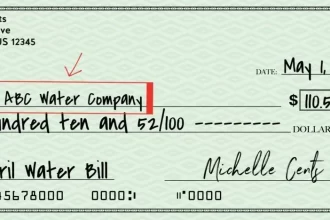In this article, we’ll address the question: “How many backlinks should a website have?” More importantly, we’ll dive into the number of backlinks required for each page to secure a spot in Google’s search results.
By the time you finish reading, you’ll have a clear understanding of the optimal number of links your website should aim for.
Plus, you’ll discover strategies to achieve better rankings with fewer backlinks than you might have initially thought necessary.
If you find this article interesting, be sure to explore the SEO Chatter blog, where I regularly share similar content.
How many backlinks are needed to get ranked on the first page of Google?

To do well in online search results, a website usually needs around 40 to 50 links from other sites to its main page and anywhere from 0 to 100 links for each of its other pages.
But here’s your attention: not all Backlinks are the same. Some are more powerful, and it’s these strong links that matter most because they can help your site climb higher in search rankings. So, if you’re thinking long-term and aiming to do really well in search results, you should try to get the best quality links possible.
Read also: Is content length a ranking factor?
It’s not about having lots of links but having great ones. In fact, having just one excellent link from a high-ranking site (we call it a PR9) can be more valuable than having ten not-so-great links from lower-ranking sites (we call them PR1).
In a nutshell, it’s not about the number of links, but the quality, especially if you want your website to perform better in search engines.
Which factor decides how many backlinks are required to be ranked higher?
The number of backlinks your website needs can vary depending on several factors. Here are some key factors that affect how many backlinks your website may require:
1. Domain Authority:
Domain Authority (DA) is a website measure, created by Moz, that tells us how strong a website is overall. It’s like a website’s power level.
Ahrefs uses this metric as Domain Rating (DR), which is similar but focuses on the quality of the websites linking to it. It’s like saying how strong a website’s friends are.
Semrush has its version called Authority Score (AS), which is like DA but adapted to measure how good a website is for SEO. All these metrics use a scale from 1 to 100, with higher numbers meaning a stronger website that’s more likely to do well in Google searches.
So, if everything else about the two websites is the same—like the quality of their content, how well they match what people are searching for, and how well they’ve set up their website for search engines—the one with the higher DA, DR, or AS should rank higher on Google.
But sometimes, it doesn’t work that way, and we’ll explain why in the next section about Keyword Difficulty.
Usually, it’s because Google looks at things like who’s linking to a website when deciding where to put it in search results. If a website has lots of high-quality websites linking to it, its domain authority goes up. This makes it seem more valuable to people using the internet, and as a result, Google’s ranking algorithm may boost it higher in search results.
2. Keyword Difficulty:
Keyword difficulty is another metric that SEO tools use to guess how hard it might be to get a web page to show up on the first page of Google for a particular keyword. They use a scale from 1 to 100, where higher numbers mean it’s tougher to compete.
This difficulty score depends on four things:
- Domain Authority: This is how strong the whole website is.
- Page Authority: It’s about how strong a specific page on the website is.
- Citation Flow: This measures how many backlinks (links from other websites) a specific page has.
- Trust Flow: It’s about the quality of those backlinks. Not just how many, but how good they are.
So, it’s not just about how popular a website is (Domain Authority), but also how strong a single page is, how many other websites link to it, and how good those links are.
Here’s the twist: Even if a website has a lower Domain Authority than another, it can still beat it in the search results if the individual page has really good quality backlinks. These metrics don’t think about how well the page is set up for search engines (on-page SEO), which can sometimes be even more important than backlinks.
For some keywords, having a well-optimized page that matches what people are searching for can make Google put it at the top, even if it doesn’t have as many backlinks as other pages. So, it’s not just about the number of backlinks; it’s also about how well the page is set up for search engines.
3. Internal Linking:
The number of internal links a web page gets is another factor that affects how many backlinks it should have.
Internal links are links from one page on a website to another page on the same website. There have been many studies in the world of SEO that show how internal links can boost a web page’s rankings in search results.
Some SEO tests even suggest that having three internal links can be as powerful as having one external backlink from another website.
Google itself has mentioned that the more internal links a page has, the more it tells Google’s search engine that this page is important for users. As a result, Google may give it higher visibility in search results.
So, if you want certain pages on your website to rank well in search results, it’s a good idea to include internal links to those pages using anchor text (clickable words) that include relevant keywords.
However, it’s important to make sure that the internal links make sense contextually and are not placed randomly, as Google’s indexing algorithm also considers the text around the internal links to understand their relevance.
Myth about Backlink in Word of SEO
It’s true that getting more backlinks for your website and individual web pages can be quite challenging. Google doesn’t encourage this practice because it prefers backlinks to happen naturally and organically on the internet.
As mentioned earlier, you don’t always require a massive number of backlinks to reach the top positions on Google. To improve your rankings with fewer backlinks, here are some SEO best practices to consider:
- Keyword Selection: Optimize your page for 3-5 keywords with low keyword difficulty scores. This means targeting keywords that are not extremely competitive.
- On-Page SEO: Implement excellent on-page SEO by placing your chosen keywords in the right HTML locations for Google to easily understand and crawl.
- User Intent: Ensure that your content meets user search intent. Study the top-ranking websites for your main keyword to understand the type of content that is performing well, and create something similar.
- Internal Links: After publishing your article, create at least 5 contextual internal links to the page, using anchor text that includes keywords related to the content.
- Homepage Link: If possible, link to the web page from your homepage. The homepage typically passes the most internal PageRank value, which can boost the page’s importance.
- Build Domain Authority: Focus on building high-quality backlinks to your homepage to increase the overall authority of your entire website, rather than just individual pages.
- Additional Backlinks: Once you’ve optimized your web page and internal SEO signals to the best of your ability, then consider seeking more backlinks for that specific page.
You might discover that by following these steps and optimizing your web page effectively, you need fewer backlinks than you initially thought to rank well for your chosen keywords.
Remember that quality and relevance matter more than quantity when it comes to backlinks and SEO.
Tips: Want to rank higher in Google search? Follow these steps
We all know well that the number of backlinks required to rank on the first page of Google varies widely depending on several factors, including the competitiveness of your target keyword, the quality of the backlinks, and the overall quality and relevance of your website’s content.
In General, 40-50 backlinks are required to rank higher if the Keyword difficulty of your target keyword is 50 plus.
Here are some key points to consider
- Keyword Competition: Highly competitive keywords with a lot of search volume will typically require more high-quality backlinks to rank on the first page. Less competitive or long-tail keywords may require fewer backlinks.
- Backlink Quality: Quality matters more than quantity. A few high-quality backlinks from authoritative websites in your niche can be more effective than many low-quality backlinks.
- Content Quality: The content on your website must be valuable, relevant, and well-optimized for the target keyword. High-quality content can attract natural backlinks.
- On-Page SEO: Proper on-page optimization, including keyword usage, meta tags, and website structure, is crucial to complement your backlink efforts.
- Local vs. Global: The type of ranking you’re aiming for also matters. Local rankings for specific geographic areas may require a different approach than global rankings.
- Link-Building Strategy: Your link-building strategy matters. Building backlinks in a natural, ethical, and white-hat manner is essential. Avoid black-hat SEO techniques, which can lead to penalties from search engines.
- Time Frame: Ranking on the first page of Google can take time. It’s not something that typically happens overnight, especially for competitive keywords.
There is no fixed number of backlinks that guarantees first-page ranking on Google because it’s a dynamic and ever-changing landscape. Your goal should be to focus on quality over quantity, create valuable content, and engage in ethical SEO practices.
How Many Backlinks Do You Need to Rank Summary
I hope you found this guide helpful in addressing the question of how many backlinks are needed to rank on Google.
As you’ve learned, the ideal number of backlinks for a website varies based on several factors, such as domain authority, page authority, citation flow, and trust flow of those links.
But it’s crucial to remember that backlink metrics are just one piece of the puzzle when it comes to ranking well on search engines. Sometimes, superior on-page SEO and strategic internal linking can give you an edge over your competitors in search engine results.
About Us
SEOByMasroor.Com, is the place where we make learning easy. We’re here to help you with simple and clear instructions for all the things you want to learn. We believe that everyone can learn. SEOByMasroor is here to help you become better at things and make life a little simpler.





